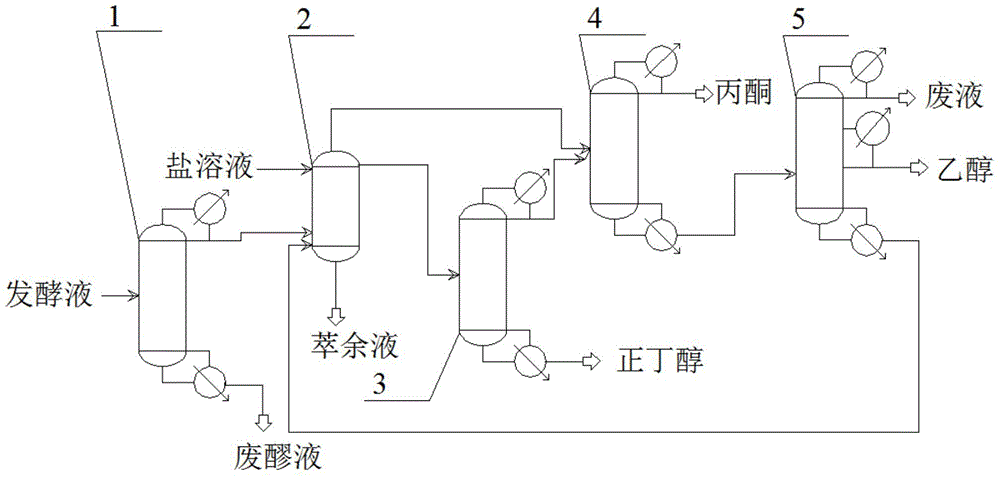Ethanol, acetone and n-butanol salting-out composite rectification separation recovery method and apparatus
A rectification separation and n-butanol technology, applied in the separation/purification of hydroxyl compounds, carbonyl compounds, organic chemistry, etc., can solve the problem of low total solvent concentration, many impurities, and n-butanol in separation / water azeotrope and other problems, to achieve the effect of high solubility, good stability and easy recovery
- Summary
- Abstract
- Description
- Claims
- Application Information
AI Technical Summary
Problems solved by technology
Method used
Image
Examples
Embodiment 1
[0043] A salting-out composite rectification separation and recovery method for ethanol, acetone and n-butanol, comprising the steps of:
[0044] a) The cooked fermented mash is degassed (to remove CO 2 and H 2 ) after, it is sent into the beer tower 1 to carry out the concentration of the total solvent, and realize the separation of glucose, protein and solids etc. simultaneously. The composition of fermented mash is 95.0% water, 1.08% n-butanol, 0.54% acetone, 0.18% ethanol, and the rest are impurities such as glucose, protein and solids. After the fermented mash is preheated to a temperature of 85°C to 90°C, it is pumped into the middle of the mash tower 1 with a feed rate of 25,000kg / h. The bottom of the tower is heated by direct steam, and the pressure at the bottom of the tower is 2×10 4 ~3×10 4Pa, the temperature at the bottom of the tower is 106-108°C, the liquid level at the bottom of the tower is controlled at 1 / 2-2 / 3; the temperature at the top of the tower is 9...
Embodiment 2
[0051] A salting-out composite rectification separation and recovery method for ethanol, acetone and n-butanol, comprising the steps of:
[0052] a) The cooked fermented mash is degassed (to remove CO 2 and H 2 ) after, it is sent into the beer tower 1 to carry out the concentration of the total solvent, and realize the separation of glucose, protein and solids etc. simultaneously. The composition of fermented mash is 96.0% water, 1.08% n-butanol, 0.55% acetone, 0.17% ethanol, and the rest are impurities such as glucose, protein and solids. After the fermented mash is preheated to a temperature of 85°C to 90°C, it is pumped into the middle of the mash tower 1 with a feed rate of 25,000kg / h. The bottom of the tower is heated by direct steam, and the pressure at the bottom of the tower is 2×10 4 ~3×10 4 Pa, the temperature at the bottom of the tower is 106-108°C, the liquid level at the bottom of the tower is controlled at 1 / 2-2 / 3; the temperature at the top of the tower is ...
Embodiment 3
[0059] A salting-out composite rectification separation and recovery method for ethanol, acetone and n-butanol, comprising the steps of:
[0060] a) The cooked fermented mash is degassed (to remove CO 2 and H 2 ) after, it is sent into the beer tower 1 to carry out the concentration of the total solvent, and realize the separation of glucose, protein and solids etc. simultaneously. The composition of fermented mash is 94.0% water, 1.09% n-butanol, 0.54% acetone, 0.17% ethanol, and the rest are impurities such as glucose, protein and solids. After the fermented mash is preheated to a temperature of 85°C to 90°C, it is pumped into the middle of the mash tower 1 with a feed rate of 25,000kg / h. The bottom of the tower is heated by direct steam, and the pressure at the bottom of the tower is 2×10 4 ~3×10 4 Pa, the temperature at the bottom of the tower is 106-108°C, the liquid level at the bottom of the tower is controlled at 1 / 2-2 / 3; the temperature at the top of the tower is ...
PUM
 Login to View More
Login to View More Abstract
Description
Claims
Application Information
 Login to View More
Login to View More - Generate Ideas
- Intellectual Property
- Life Sciences
- Materials
- Tech Scout
- Unparalleled Data Quality
- Higher Quality Content
- 60% Fewer Hallucinations
Browse by: Latest US Patents, China's latest patents, Technical Efficacy Thesaurus, Application Domain, Technology Topic, Popular Technical Reports.
© 2025 PatSnap. All rights reserved.Legal|Privacy policy|Modern Slavery Act Transparency Statement|Sitemap|About US| Contact US: help@patsnap.com



